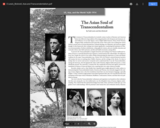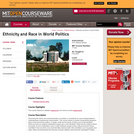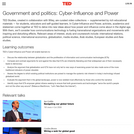
An introduction to the chapter "Adapting and Living Together" within the Ecology and Environment topic of the virtual school GCSE Biology.
- Material Type:
- Diagram/Illustration
- Lecture
- Syllabus
- Unit of Study
- Date Added:
- 02/21/2013

An introduction to the chapter "Adapting and Living Together" within the Ecology and Environment topic of the virtual school GCSE Biology.

An article written by Todd Lewis that was published in Education About Asia in 2011 that discuses what educators need to know when they prepare to teach Transcendentalism and it's Asian influence.
Introduction:
The treatment of Transcendentalism by twentieth-century teachers of literature and American history has followed a long tradition of focusing primarily on the European and American cultural influences on its major figures, such as Ralph Waldo Emerson, Henry David Thoreau, Margaret Fuller, and Bronson and Louisa May Alcott. Their work is seen as fitting into various Western currents such as German Romanticism, Unitarian theology, neo-Platonism...

This course is the intermediate level of the streamlined curriculum, which is intended for students who, when they began streamlined I, had some background in the language, whether it be comprehension with limited speaking ability or quite fluent speaking ability. The focus of the course is on standard pronunciation and usage, on reading in both complex and simplified characters, and on writing. It is presupposed that students in Chinese III have already learned the pinyin system of representing pronunciation sufficiently well to be able to read texts in pinyin accurately. (If not, there are pinyin tutorials to assist you to learn the system.)

This subject is the second semester of four that forms an introduction to modern standard Chinese, commonly called Mandarin. The emphasis is on further developing students’ abilities to participate in simple, practical conversations on everyday topics as well as enhancing their abilities on reading and writing. The relationship between Chinese language and culture and the sociolinguistically appropriate use of language will be stressed throughout. A typical class includes performance of memorized basic conversations, drills, questions and discussion, and various types of communicative exercises. At the end of this course, students are expected to develop an understanding of the language learning process so that they will be able to continue studying effectively on their own.

Kishore Mahbubani, author of Beyond the Age of Innocence: Rebuilding Trust between America and the World and Can Asians Think? joins Conversations host Harry Kreisler for a discussion about America and the world. (55 min)

Author of numerous books on war, conflict, reconstruction and foreign policy, guest Nayan Chanda, The Director of Publications for the Center of Study of Globalization at Yale University, joins host Harry Kreisler to discuss regional stability in Asia. (52 min)

Conversations host Harry Kreisler welcomes Robert A. Scalapino, the Robson Research Professor of Government Emeritus and founding Director of the Institute of East Asian Studies at U.C Berkeley. Professor Scalapino discusses Berkeley's evolution as a leading center for Asian Studies, analyzes the synergy between academic research and foreign policy, and comments on the transformation of America's relationship with Asia which he has witnessed over the course of his six decade career. (55 minutes)

Conversations host Harry Kreisler welcomes Kishore Mahbubani for a discussion of the changing relationship between the West and Asia. In the interview, he describes the major transformations occurring because of the "march of modernity" made possible by the ideas and global institutions created by the West. He goes on to criticize the West for failing to adapt to the changing balance of power which follows from Asia's rise. (57 minutes)

This course examines cultural performances of Asia, including both traditional and contemporary forms, in a variety of genres. Students will explore the communicative power of performances with attention to the ways performers, media, cultural settings, and audiences interact. The representation of cultural difference is considered and how it is altered through processes of globalization. Performances are viewed live when possible, but the course also relies on video, audio, and online materials as necessary. There are no prerequisites for this course and it is taught in English.

This is a collection of downloadable video clips on the theme of Economic Systems, with guiding questions for students. Clips are drawn from the following PBS WIDE ANGLE documentaries: "To Have and Have Not" (2002), "A State of Mind" (2003), "Ladies First" (2004), "1-800-INDIA" (2005), "Border Jumpers" (2005).

Discerning the ethnic and racial dimensions of politics is considered by some indispensable to understanding contemporary world politics. This course seeks to answer fundamental questions about racial and ethnic politics. To begin, what are the bases of ethnic and racial identities? What accounts for political mobilization based upon such identities? What are the political claims and goals of such mobilization and is conflict between groups and/or with government forces inevitable? How do ethnic and racial identities intersect with other identities, such as gender and class, which are themselves the sources of social, political, and economic cleavages? Finally, how are domestic ethnic/racial politics connected to international human rights? To answer these questions, the course begins with an introduction to dominant theoretical approaches to racial and ethnic identity. The course then considers these approaches in light of current events in Africa, Asia, Latin America, Europe, and the United States.

Discerning the ethnic and racial dimensions of politics is considered by some indispensable to understanding contemporary world politics. This course seeks to answer fundamental questions about racial and ethnic politics. To begin, what are the bases of ethnic and racial identities? What accounts for political mobilization based upon such identities? What are the political claims and goals of such mobilization and is conflict between groups and/or with government forces inevitable? How do ethnic and racial identities intersect with other identities, such as gender and class, which are themselves the sources of social, political, and economic cleavages? Finally, how are domestic ethnic/racial politics connected to international human rights? To answer these questions, the course begins with an introduction to dominant theoretical approaches to racial and ethnic identity. The course then considers these approaches in light of current events in Africa, Asia, Latin America, Europe, and the United States.

From pineapples grown in Hawaii to English-speaking call centers outsourced to India, the legacy of the “Age of Imperialism” appears everywhere in our modern world. This class explores the history of European imperialism in its political, economic, and cultural dimensions from the 1840s through the 1960s.

Modernization is an important issue in the New York State Global History and Geography curriculum. Students are expected to understand how modernization may impact such areas as society, politics, the economy, and the environment. In the Global History and Geography curriculum, a study of historical examples of modernization includes examples of attempts to transform society, such as the Meiji Restoration or Kemal Ataturk. In this lesson, two PBS WIDE ANGLE documentaries -- "To Have and Have Not" (2002) and "1-800-INDIA" (2005) -- will enable students to examine the effects of modernization on two Asian countries: China and India.

After decades of efforts to promote development, why is there so much poverty in the world? What are some of the root causes of inequality world-wide and why do poverty, economic transformations and development policies often have different consequences for women and men? This course explores these issues while also examining the history of development itself, its underlying assumptions, and its range of supporters and critics. It considers the various meanings given to development by women and men, primarily as residents of particular regions, but also as aid workers, policy makers and government officials. In considering how development projects and policies are experienced in daily life in urban and rural areas in Africa, Latin America, Asia and Melanesia, this course asks what are the underlying political, economic, social, and gender dynamics that make “development” an ongoing problem world-wide.

This resource is a video abstract of a research paper created by Research Square on behalf of its authors. It provides a synopsis that's easy to understand, and can be used to introduce the topics it covers to students, researchers, and the general public. The video's transcript is also provided in full, with a portion provided below for preview:
"Glaciers and ice sheets may seem dead and empty to the naked eye, but the dust that coats them, cryoconite, is a hotspot for microbes and microbe-driven biogeochemical cycling. However, little is known about the geographical diversity in cryoconite microbial communities. Most cryoconite research focuses on polar microbial communities, and reports on Asia’s high mountain glaciers are rare. A recent metagenomics study found key metabolic and light harvesting differences between polar and Asian alpine cryoconite microbiota. The Asian cryoconite community had more abundant genes for denitrification, suggesting that denitrification is enhanced there compared to polar regions. While Asian cryoconite is dominated by multiple cyanobacterial lineages that possess phycoerythrin, a green-light harvesting protein, polar cryoconite is dominated by a single cyanobacterial species (_Phormidesmis priestleyi_) that lacks phycoerythrin..."
The rest of the transcript, along with a link to the research itself, is available on the resource itself.

Today, over 115 million children have never set foot inside a school. The fact is that for children living in developing countries, the dream of a first day of school is yet to be realized. The daily realities of poverty, political instability, regional conflict, geography, and cultural or traditional values all play a role to varying degrees -- and the issue of gender disparity makes this fact even more staggering. Full and equal access to education (Article 26) as outlined in the 'Universal Declaration of Human Rights' and 'The Convention on the Rights of the Child' (Articles 2,3,28, and 29), has clearly been out of the reach of poor children -- and even more so in the case of girls. Nearly two-thirds of children who are denied a primary education are girls. In the least developed countries, nearly twice as many adult women than men are illiterate. (Source: UNFPA http://www.unfpa.org/icpd/10/icpd_ed.htm) If you happen to be a female, you are less likely to have access to a quality primary education and beyond -- contributing to the feminization of global poverty. Yet, there is hope despite this current state of affairs. 189 nations have pledged to meet 8 major Millennium Development Goals (MDGs) by 2015. In doing so, nations hope to improve the social and economic development of all peoples. Included in these goals are those that address education and gender disparity: MDG 2: Achieve universal and primary education. MDG 3: Promote gender equality and empower women. Through the activities outlined in this lesson, students will become familiar with the current barriers standing in the way of educational opportunity -- especially for girls. They will watch clips from the WIDE ANGLE film 'Time for School' (2003) to understand the sense of urgency surrounding this issue, the potential benefits that can result from educating girls, and the ways that local communities are trying to address these problems. Note: This lesson focuses on MDG 2 and MDG 3. An introduction to the overall goals of the Millennium Project should be presented prior to this particular lesson.

This course examines the opportunities and risks firms face in today’s global world. The course provides conceptual tools for analyzing how governments and a variety of social and economic institutions influence competition among firms embedded in different national settings. Public policies and institutions that shape competitive outcomes are examined through cases and analytic readings on different companies and industries operating in both developed and emerging markets. In addition to traditional case/class discussions, this course will include some presentations by various guest speakers. The hope is that greater exposure to/interaction with these real-world practitioners will “bring to life” some of the issues discussed in the readings/cases. Whenever possible, informal dinners and/or coffees will be organized for small groups of students interested in meeting with our guest speakers.

TED Studies, created in collaboration with Wiley, are curated video collections supplemented by rich educational materials for students, educators and self-guided learners. In Cyber-Influence and Power, activists, academics and statesmen come together at TED to delve into new ideas about how power and influence come about in the digital age. With them, we'll consider how communications technology is fueling transnational organizations and movements with inspiring and disturbing effects.

History of Asia (History 2205) Resource List. Compiled Summer-Fall 2021 by Dr. Maria Ritzema. The following materials are freely available online and are licensed as indicated in the source material. This resource will be updated as needed. For the most recent version, visit: https://drive.google.com/drive/folders/1MKxzEAGLta-5zjCBUGey7Pg-fCv5RgoA?usp=sharing